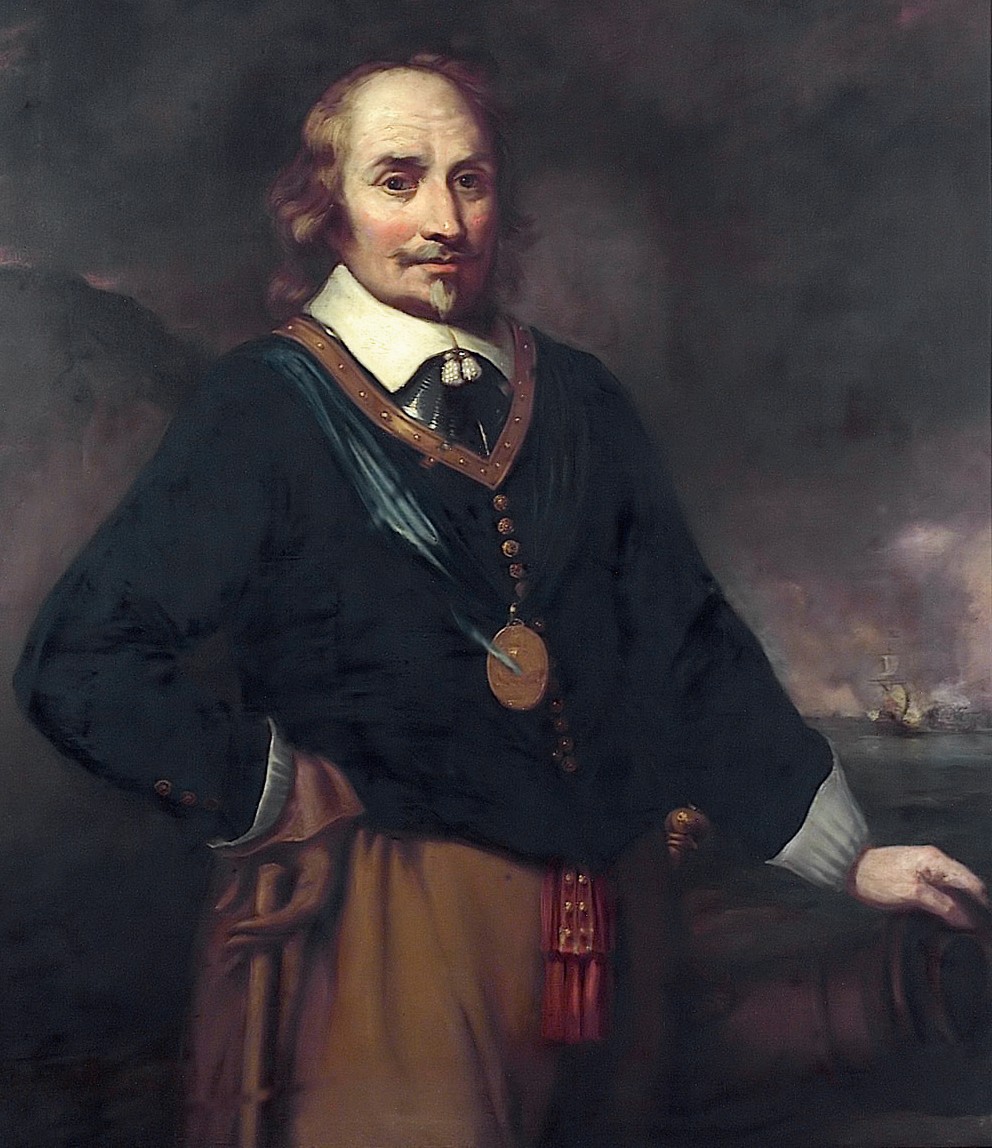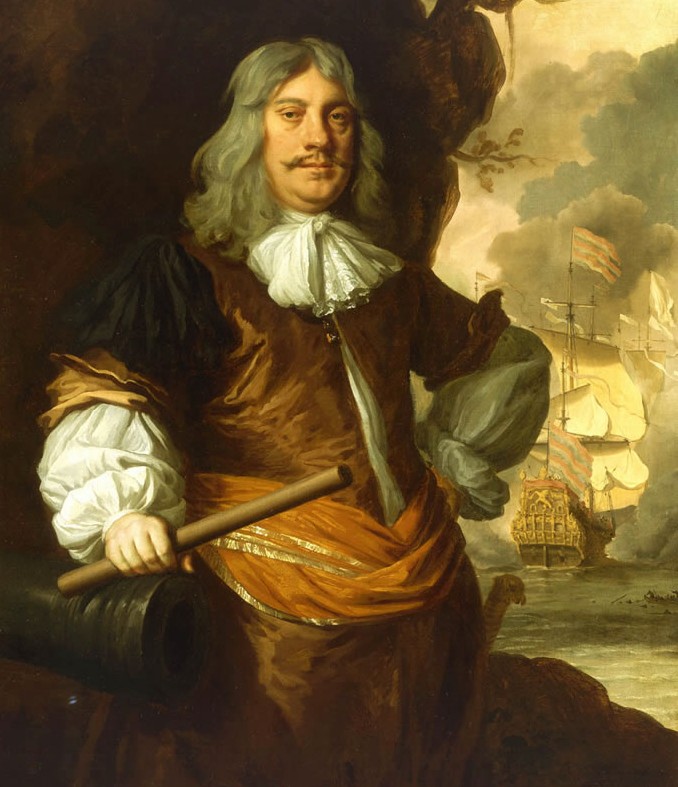Admiral Maarten Harpertszoon Tromp (April 23, 1598 - August
10, 1653):
Born in Den Briel, Tromp was the
son of an officer of an early Dutch man-of-war; his mother
washed sailor's shirts to supplement the family income. At
the age of nine, Tromp went to sea with his father and was
present at the Battle of Gibraltar. Three years later they
sailed together on a merchant ship to Africa, when they were
attacked by the English pirate Peter Easton and Tromp's
father was slain. According to legend the 12-year old boy
rallied the crew of the ship with the cry "Won't you avenge
my father's death?" But the pirates seized him and sold him
on the slave market of Salé. Two years later however,
Easton, moved by pity, ordered his redemption. Set free, he
supported his mother and three sisters by working in a
Rotterdam shipyard, went to sea again at 19, and three years
later was captured once more - this time by Barbary corsairs
off Tunis. He was kept as a slave until 24, and by then had
so impressed the bey of Tunis with his skills in gunnery and
navigation that he was again set free. He joined the Dutch
navy as a lieutenant in 1621. His first distinction was as
Piet Hein's flag captain on the Vliegende Groene Draeck
during the fight with Ostend privateers in 1629 in which
Hein was killed.
Tromp, left the naval service for
a few years, but was promoted from captain to
Lieutenant-Admiral of Holland and West Frisia in 1637, when
Lieutenant-Admiral Philips van Dorp and other flag officers
were removed for incompetence. Although formally under the
Admiral-General Frederick Henry of Orange, he was in fact
supreme commander of the Dutch fleet, as the stadtholders
never fought in naval combat. Tromp was mostly occupied in
blockading the privateer port of Dunkirk.
In 1639, during the Dutch
struggle for independence from Spain, Tromp defeated a large
Spanish fleet bound for Flanders at the Battle of the Downs,
marking the end of Spanish naval power. In a preliminary
battle, the Action of 18 September 1639, Tromp was the first
fleet commander known to deliberately use line of battle
tactics. His flagship in this period was the Aemilia.
In the First Anglo-Dutch War of
1652-1653 Tromp commanded the Dutch fleet in the battles of
Dungeness, Portland, the Gabbard and Scheveningen. In the
last of these, he was killed by a sharpshooter in the
rigging of William Penn's ship. His acting flag captain,
Egbert Bartholomeusz Kortenaer, on the Brederode kept up
fleet morale by not lowering Tromp's standard, pretending
Tromp was still alive.
The death of Maarten Tromp was
not only a severe blow to the Dutch navy, but also to the
Orangists who sought the defeat of the Commonwealth of
England and restoration of the Stuart monarchy; Republican
influence strengthened after Scheveningen, which led to
peace negotiations with the Commonwealth, culminating in the
Treaty of Westminster.
During his career, his main rival
was Vice-Admiral Witte de With, who also served the
Admiralty of Rotterdam (the Maas) from 1637. De With
temporarily replaced him as supreme commander for the Battle
of Kentish Knock. Tromp's successor was Lieutenant-Admiral
Jacob van Wassenaer Obdam.
Tromp, a "sea hero", was
immensely popular with the common people, a sentiment
expressed by the greatest of Dutch poets, Joost van den
Vondel in a famous poem describing his marble grave monument
in Delft showing the admiral on his moment of death with a
burning British fleet on the foreground:
Here rests the hero Tromp,
the brave protector
of shipping and free
sea, serving free land
his memory alive in
artful spectre
as if he had just died
at his last stand
His knell the cries of
death, guns' thunderous call
a burning Brittany too
Great for sea alone
He's carved himself an
image in the hearts of all
more lasting than
grave's splendour and its marble stone.
One of Tromp's sons, Cornelis
Tromp later also became commander of the Dutch navy, as
Lieutenant-Admiral-General, and even earlier commanded the
Danish navy.
source: wikipedia |

Maarten Harpertszoon Tromp
|
Lieutenant-Admiral-General Cornelis Maartenszoon Tromp
(September 9, 1629 - May 29, 1691):
Cornelis Tromp was born in
Rotterdam, the second son of the later Lieutenant-Admiral
Maarten Tromp and Dignom Cornelisdochter de Haes.
In 1642 he was sent to Harfleur
in France to learn the language from a calvinist preacher.
On 1 September 1643 he joined his father on his flagship the
Aemilia. In September 1645 he was appointed as lieutenant.
On 22 August 1649 he was made a full captain.
He served in the First
Anglo-Dutch War, fighting in the Battle of Leghorn, but
wasn't given command of the Mediterranean fleet after the
death of Johan van Galen, only being promoted to
Rear-Admiral with the Admiralty of the Maas on 11 November
1653 after the death of his beloved father Maarten.
In 1656 he participated in the
relief of Gdańsk (Danzig). In 1658 it was discovered he had
used his ships to trade in luxury goods; as a result he was
fined and not allowed to have an active command until 1662.
Just before the Second Anglo-Dutch War he was promoted to
Vice-Admiral on 29 January 1665; at the Battle of Lowestoft
he prevented total catastrophe by taking over fleet command
to allow the escape of the larger part of the fleet.
Gaining thus a sudden popularity
he was then on 23 July 1665 temporarily given supreme
command of the confederate fleet as Lieutenant Admiral, but
had to give up this function (but not rank) the next month
in favour of Lieutenant-Admiral Michiel de Ruyter; he
fought, having been transferred to the Admiralty of
Amsterdam on 6 February 1666, under the latter in the Four
Days Battle and the St. James's Day Battle. As this failure
off Nieuwpoort in August 1666 was imputed to him by De
Ruyter he was dismissed, at the same time being under the
suspicion of plotting to overthrow the government, but he
returned in April 1673, after the Orangists seized power, to
fight against the French and English navies in the Third
Anglo-Dutch War where he participated in the last three
fleet actions under Lieutenant-Admiral-General Michiel de
Ruyter, distinguishing himself in the double Battle of
Schooneveld and the Battle of Texel in August 1673 fighting
out an epic duel with his personal enemy Edward Spragge, who
drowned.
He was closely involved in the
murder of Johan de Witt and Cornelis de Witt in 1672. In
1675 he was created a baronet by Charles II of England but
he refused an honorary doctorate when visiting Oxford.
On 8 May 1676 he became
Admiral-General of the Danish navy and Knight in the Order
of the Elephant; in 1677 a Danish count. He defeated the
Swedish navy in the Battle of Öland, his only victory as a
fleet commander. On 6 February 1679 he became
Lieutenant-Admiral-General of the Republic but never fought
in that capacity, having become a liability to the new
regime of William III. He died in Amsterdam in 1691, his
mind broken by alcohol abuse and remorse, still officially
commander of the Dutch fleet, after having been for a period
replaced by Cornelis Evertsen the Youngest.
source: wikipedia |

Cornelis Maartenszoon Tromp
|
|


































